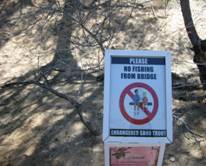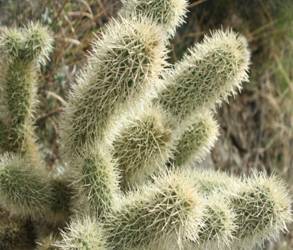

CHASING SAND TROUT
 As a dyed in the wool trout fisher spending my winters in Arizona was like a
drug addict quitting crystal meth cold turkey. Although there are some limited
trout angling opportunities in the land of cactus and Gila monsters they
mostly consist of fish that have been stocked for the bait and lure anglers.
You can imagine my surprise and delight when I discovered that there were
some native trout living right in the Sonoran desert where I was living.
As a dyed in the wool trout fisher spending my winters in Arizona was like a
drug addict quitting crystal meth cold turkey. Although there are some limited
trout angling opportunities in the land of cactus and Gila monsters they
mostly consist of fish that have been stocked for the bait and lure anglers.
You can imagine my surprise and delight when I discovered that there were
some native trout living right in the Sonoran desert where I was living.
Sand trout [Salmo silica] are native to the dry washes and dewatered rivers and streams of the desert southwest. They are very elusive and many of the possible angling locations have been closed to all angling because of the limited number of these native fish that still remain. I covered vast stretches of the Sonoran desert in pursuit of a dry wash that would allow me to angle for the elusive and highly prized sand trout, and after much searching I finally found a wash that was open to angling.
I was told that the best time to angle for sand trout is during the winter season, since the heat can be brutal during the summer months and sometimes the washes fill with water which completely ruins your chances of catching a sand trout.
Since finding a place to angle for sand trout is such an arduous task, the exact location of my angling adventure shall remain secret. It is a delightful stretch of sand and gravel interspersed with outcroppings of rocks, and piles of debris from the monsoon floods. The hillsides are covered with Saguaro cactus, and along the banks are Mesquite and Palo Verde trees interspersed with cholla and prickly pear cactus. It was an idyllic setting in which one could spend a mid-winter day avoiding scorpions and rattlesnakes while seeking the elusive sand trout.
I chose a 9 foot rod outfitted with a 3 weight sand-colored weight forward floating line and a 12 foot leader tapered to 7x. I had tied up a goodly selection of sand flies, desert gnats, and sand worms. Thus equipped I set out to capture my first sand trout.
Alas my story has no happy ending. On my way to the wash I brushed against a teddy-bear cholla and spent most of the morning extracting the spines from a part of my anatomy that shall remain unmentioned. Although that was several months ago now I am still extracting spines from places that are hard to reach and unpleasant to contemplate.
 After my brush with the cholla I finally arrived at the wash. I did not see any
hatching insects but I presumed that the sand trout would not be too selective
so I chose a common sand fly as my first offering. In my excitement I failed to
check behind me and I promptly hooked a bush. Forgetting where I was I reached
out to remove my fly and promptly impaled my hand on the sharp thorns of a cat
claw acacia. The thought of that moment still brings tears to my eyes. Smarting
from cholla spines and bleeding from my encounter with the acacia I forged
ahead in my pursuit of the sand trout.
After my brush with the cholla I finally arrived at the wash. I did not see any
hatching insects but I presumed that the sand trout would not be too selective
so I chose a common sand fly as my first offering. In my excitement I failed to
check behind me and I promptly hooked a bush. Forgetting where I was I reached
out to remove my fly and promptly impaled my hand on the sharp thorns of a cat
claw acacia. The thought of that moment still brings tears to my eyes. Smarting
from cholla spines and bleeding from my encounter with the acacia I forged
ahead in my pursuit of the sand trout.
Several hours later I had hooked two Saguaro cacti, irritated a rather large and very unfriendly western diamond-backed rattlesnake, released two unhappy scorpions that thought my sand fly imitation was edible prey, and got a very bad sunburn from the sun reflecting off the sand. Despite all my best efforts the sand trout eluded me. Such is the plight of the sand trout angler.
Now I am back home in Montana where winter is still firmly in control of the weather and the fishing. After a long winter chasing sand trout in Arizona I have returned to a much wetter and colder Montana, but to date the trout have seemed to be almost as elusive as those Arizona trout.